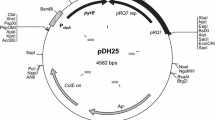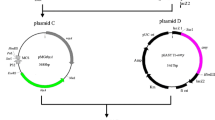Abstract
Threonine aldolases (TAs) are useful enzymes for the synthesis of β-hydroxy-α-amino acids due to their capability to catalyze asymmetric aldol reactions. Starting from two prochiral compounds, an aldehyde and glycine, two chiral stereocenters were formed in a single step via C–C bond formation. Owing to poor diastereoselectivity and low activity, the enzymatic synthesis of β-hydroxy-α-amino acids by TAs is still a challenge. For identification of new TAs, a growth-dependent selection system in Pseudomonas putida KT2440 has been developed. This bacterium is able to use aromatic compounds such as benzaldehyde, which is the cleavage product of the TA-mediated retro-aldol reaction of phenylserine, as sole carbon source via the β-ketoadipate pathway. With dl-threo-β-phenylserine as sole carbon source, this strain showed only slight growth in minimal medium. This growth deficiency can be restored by introducing and expressing genes encoding TAs. In order to develop a highly efficient selection system, the gene taPp of P. putida KT2440 encoding a TA was successfully deleted by replacement with an antibiotic resistance cassette. Different growth studies were carried out to prove the operability of the selection system. Genes encoding for l- and d-specific TAs (l-TA genes of Escherichia coli (ltaE) and Saccharomyces cerevisiae (gly1) and d-TA gene of Achromobacter xylosoxidans (dtaAX)) were introduced into the selection strain P. putida KT2440ΔtaPp, followed by cultivation on minimal medium supplemented with dl-threo-β-phenylserine. The results demonstrate that only the selection strains with plasmid-encoded l-TAs were able to grow on this racemic amino acid, whereas the corresponding strain harboring the gene coding for a d-specific TA showed no growth. In summary, it can be stated that a powerful screening tool was developed to identify easily by growth new l-specific threonine aldolases or other enzymes from genomic or metagenomic libraries liberating benzaldehyde.



Similar content being viewed by others
References
Alexeyev MF, Shokolenko IN, Croughan TP (1995) Improved antibiotic-resistance gene cassettes and omega elements for Escherichia coli vector construction and in vitro deletion/insertion mutagenesis. Gene 160:63–67
Chalova VI, Sirsat SA, O’Bryan CA, Crandall PG, Ricke SC (2009) Escherichia coli, an intestinal microorganism, as a biosensor for quantification of amino acid bioavailability. Sensors (Basel) 9:7038–7057
Clapés P, Garrabou X (2011) Current trends in asymmetric synthesis with aldolases. Adv Synth Catal 353:2263–2283
Contestabile R, Paiardini A, Pascarella S, di Salvo ML, D’Aguanno S, Bossa F (2001) L-Threonine aldolase, serine hydroxymethyltransferase and fungal alanine racemase. A subgroup of strictly related enzymes specialized for different functions. Eur J Biochem 268:6508–6525
Cosloy SD, McFall E (1973) Metabolism of d-serine in Escherichia coli K-12: mechanism of growth inhibition. J Bacteriol 114:685–694
Drepper T, Eggert T, Hummel W, Leggewie C, Pohl M, Rosenau F, Wilhelm S, Jaeger K-E (2006) Novel biocatalysts for white biotechnology. Biotechnol J 1:777–786
Dückers N (2011) Screeing, biochemische Charakterisierung und Strukturaufklärung mikrobieller Threonin-Aldolasen. PhD thesis, Heinrich Heine University Düsseldorf
Dückers N, Baer K, Simon S, Gröger H, Hummel W (2010) Threonine aldolases-screening, properties and applications in the synthesis of non-proteinogenic beta-hydroxy-alpha-amino acids. Appl Microbiol Biotechnol 88:409–424
Engler C, Kandzia R, Marillonnet S (2008) A one pot, one step, precision cloning method with high throughput capability. PLoS One 3:e3647
Fesko K, Uhl M, Steinreiber J, Gruber K, Griengl H (2010) Biocatalytic access to alpha,alpha-dialkyl-alpha-amino acids by a mechanism-based approach. Angew Chem Int Ed Engl 49:121–124
Fox SW, Fling M, Bollenback N (1944) Inhibition of bacterial growth by d-leucine. J Biol Chem 155:465–468
Franz SE, Stewart JD (2014) Threonine aldolases. Adv Appl Microbiol 88:57–101
Giger L, Toscano MD, Bouzon M, Marliere P, Hilvert D (2012) A novel genetic selection system for PLP-dependent threonine aldolases. Tetrahedron 68:7549–7557
Gutierrez M, Garrabou X, Agosta E, Servi S, Parella T, Joglar J, Clapés P (2008) Serine hydroxymethyl transferase from Streptococcus thermophilus and l-threonine aldolase from Escherichia coli as stereocomplementary biocatalysts for the synthesis of beta-hydroxy-alpha, omega-diamino acid derivatives. Chemistry 14:4647–4656
Gwon H, Yoshioka H, Song N, Kim J, Song J, Jeong D, Baik S (2012) Optimal production of l-threo-2,3-dihydroxyphenylserine (l-threo-DOPS) on a large scale by diastereoselectivity-enhanced variant of l-threonine aldolase expressed in Escherichia coli. Prep Biochem Biotechnol 42:143–154
Hanahan D (1983) Studies on transformation of Escherichia coli with plasmids. J Mol Biol 166:557–580
Henning H, Leggewie C, Pohl M, Müller M, Eggert T, Jaeger K-E (2006) Identification of novel benzoylformate decarboxylases by growth selection. Appl Environ Microbiol 72:7510–7517
Jiménez JI, Miñambres B, García JL, Díaz E (2002) Genomic analysis of the aromatic catabolic pathways from Pseudomonas putida KT2440. Environ Microbiol 4:824–841
Kimura T, Vassilev VP, Shen G-J, Wong CH (1997) Enzymatic synthesis of β-hydroxy-α-amino acids based on recombinant d- and l-threonine aldolases. J Am Chem Soc 119:11734–11742
Kovach ME, Elzer PH, Hill DS, Robertson GT, Farris MA, Roop RM, Peterson KM (1995) Four new derivatives of the broad-host-range cloning vector pBBR1MCS, carrying different antibiotic-resistance cassettes. Gene 166:175–176
Lee S-J, Kang H-Y, Lee Y (2003) High-throughput screening methods for selecting l-threonine aldolases with improved activity. J Mol Catal B Enzym 26:265–272
Liu JQ, Dairi T, Kataoka M, Shimizu S, Yamada H (1997) l-allo-threonine aldolase from Aeromonas jandaei DK-39: gene cloning, nucleotide sequencing, and identification of the pyridoxal 5′-phosphate-binding lysine residue by site-directed mutagenesis. J Bacteriol 179:3555–3560
Liu JQ, Odani M, Yasuoka T, Dairi T, Itoh N, Kataoka M, Shimizu S, Yamada H (2000) Gene cloning and overproduction of low-specificity d-threonine aldolase from Alcaligenes xylosoxidans and its application for production of a key intermediate for parkinsonism drug. Appl Microbiol Biotechnol 54:44–51
Nelson KE, Weinel C, Paulsen IT, Dodson RJ, Hilbert H, Martins Dos Santos VAP, Fouts DE, Gill SR, Pop M, Holmes M, Brinkac L, Beanan M, DeBoy RT, Daugherty S, Kolonay J, Madupu R, Nelson W, White O, Peterson J, Khouri H, Hance I, Chris Lee P, Holtzapple E, Scanlan D, Tran K, Moazzez A, Utterback T, Rizzo M, Lee K, Kosack D, Moestl D, Wedler H, Lauber J, Stjepandic D, Hoheisel J, Straetz M, Heim S, Kiewitz C, Eisen JA, Timmis KN, Düsterhöft A, Tümmler B, Fraser CM (2002) Complete genome sequence and comparative analysis of the metabolically versatile Pseudomonas putida KT2440. Environ Microbiol 4:799–808
Piperno JR, Oxender DL (1968) Amino acid transport systems in Escherichia coli K12. J Biol Chem 243:5914–5920
Sagui F, Conti P, Roda G, Contestabile R, Riva S (2008) Enzymatic synthesis of ω-carboxy-β-hydroxy-(l)-α-amino acids. Tetrahedron 64:5079–5084
Sambrook J, Fritsch EF, Maniatis T (1989) Molecular cloning: a laboratory manual, 2nd edn. Cold Spring Harbor Laboratory, Cold Spring Harbor.
Simon R, Priefer U, Puhler A, Pühler A (1983) A broad host range mobilization system for in vivo genetic engineering: transposon mutagenesis in gram negative bacteria. Biotechnology 1:784–791
Steinreiber J, Fesko K, Mayer C, Reisinger C, Schürmann M, Griengl H (2007a) Synthesis of γ-halogenated and long-chain β-hydroxy-α-amino acids and 2-amino-1,3-diols using threonine aldolases. Tetrahedron 63:8088–8093
Steinreiber J, Fesko K, Reisinger C, Schürmann M, Van Assema F, Wolberg M, Mink D, Griengl H (2007b) Threonine aldolases—an emerging tool for organic synthesis. Tetrahedron 63:918–926
Studier FW, Moffatt BA (1986) Use of bacteriophage T7 RNA polymerase to direct selective high-level expression of cloned genes. J Mol Biol 189:113–130
Terfrüchte M, Joehnk B, Fajardo-Somera R, Braus GH, Riquelme M, Schipper K, Feldbrügge M (2014) Establishing a versatile Golden Gate cloning system for genetic engineering in fungi. Fungal Genet Biol 62:1–10
Tibhe JD, Fu H, Noël T, Wang Q, Meuldijk J, Hessel V (2013) Flow synthesis of phenylserine using threonine aldolase immobilized on Eupergit support. Beilstein J Org Chem 9:2168–2179
Vassilev VP, Uchiyama T, Kajimoto T, Wong C-H (1995) An efficient chemo-enzymatic synthesis of α-amino-β-hydroxy-γ-butyrolactone. Tetrahedron Lett 36:5063–5064
Acknowledgments
The authors thank the Federal Ministry of Education and Research, Germany (Bundesministerium für Bildung und Forschung, BMBF), for generous support within the programme “Biotechnologie 2020+: Basistechnologien für eine nächste Generation biotechnologischer Verfahren” (Projekt-Förderkennzeichen: 031A184). Furthermore, the authors would like to thank Dipl.- Ing. Astrid Wirtz for highly accurate measurements of the phenylserine concentration by HPLC and Dr. Kerstin Schipper, Institute for Microbiology, Heinrich Heine University Düsseldorf, for providing us with the plasmid pUMa1467.
Author information
Authors and Affiliations
Corresponding author
Electronic supplementary material
Below is the link to the electronic supplementary material.
ESM 1
(PDF 243 kb)
Rights and permissions
About this article
Cite this article
Bulut, D., Gröger, H. & Hummel, W. Development of a growth-dependent selection system for identification of l-threonine aldolases. Appl Microbiol Biotechnol 99, 5875–5883 (2015). https://doi.org/10.1007/s00253-014-6333-z
Received:
Revised:
Accepted:
Published:
Issue Date:
DOI: https://doi.org/10.1007/s00253-014-6333-z




